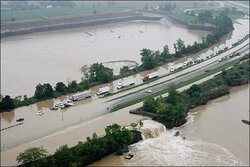ohiohearthstone
Member
I'm not crying about it, just doing something about it. Here's an idea: wouldn't it be more productive in life to say : yeah, I feel your pain, instead of nit-picking and pointing out everything that is not to your liking while saying "I could of done it better" under your breath.We all have special things in our environment that we deal with. Telling someone they are dumb for building low (when a whole land area is low) is like me telling you that you should of built underground the next time St. Hellens Blows.
Yeah the crawl might get a foot of water now and then but it does move after a few days. One would need a whole lot of dirt to build up a foundation/$$ to jack up the house. The water would still find it's way back up because the back pressure on the ditch would "push" it up". Sounds crazy, but you can go out in the field and see this happening.It's just not financially possible to jack up the house. (unless you're paying?) Oh yeah, here's some photos from some of our rain. While this isn't my house, very similar situations. It get's crazy sometimes in NW OH when it starts to rain. You have to be here. It's one of those things, either you can understand it or you call us crazy.This will be my last post...let's get back to talking about wood.
.

Yeah the crawl might get a foot of water now and then but it does move after a few days. One would need a whole lot of dirt to build up a foundation/$$ to jack up the house. The water would still find it's way back up because the back pressure on the ditch would "push" it up". Sounds crazy, but you can go out in the field and see this happening.It's just not financially possible to jack up the house. (unless you're paying?) Oh yeah, here's some photos from some of our rain. While this isn't my house, very similar situations. It get's crazy sometimes in NW OH when it starts to rain. You have to be here. It's one of those things, either you can understand it or you call us crazy.This will be my last post...let's get back to talking about wood.
.





